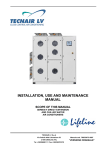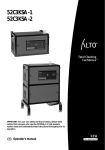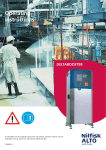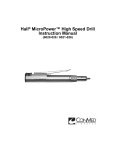Download Simplicity 1735510 Specifications
Transcript
Section 3 A/C System Components In the previous sections, we referred to the functions of the A/C components. Here’s how each one works in closer detail. A/C System Components Evaporator Expansion Valve Receiver-Drier* Condenser Expansion Valve Compressor Fig. 3-1 752f301 The expansion valve receives liquid refrigerant from the high-pressure components (compressor and receiver/drier). In order for the system to develop pressure, the flow of refrigerant must be met with a restriction. The expansion valve provides the needed restriction in the system. It creates the difference between the high-pressure side of the system and the low-pressure side. Capillary Tube Traditional Expansion Valve Controls amount of refrigerant into evaporator core. *Built into sub-cool condenser on some models Diaphragm Chamber Equalizer Circuit (for Internal Equalizer Type) Diaphragm HeatSensing Tube Valve Outlet Inlet Pressure Spring Fig. 3-2 752f302 TOYOTA Air Conditioning and Climate Control – Course 752 Home Bookmarks Next Print Exit 3-1 Section 3 Most Toyota models now use a block-type expansion valve where both the evaporator inlet and outlet pass through the valve assembly. The capillary tube is located inside the stream of refrigerant leaving the evaporator. Due to the low temperature at this point, the valve is subject to blockage by microscopic debris or internal ice if any water is present in the refrigerant. Because of this, every system has some method to filter out these elements. Block-Type Expansion Valve Releases high pressure refrigerant into evaporator. Valve Fig. 3-3 752f303 Not all vehicles use an expansion valve like the one described above. Some have a pressure-regulator at the outlet end of the evaporator. Other manufacturers use a fixed-opening orifice tube to create the pressure drop at the entry to the evaporator. This type of expansion valve relies on the cycling of the compressor clutch to vary the flow and prevent icing. The expansion valve is located at the inlet of the evaporator. A small passage creates a pressure drop as the refrigerant enters the evaporator. The pressure drop occurs as the small spray of refrigerant expands to fill the large volume inside the tubes of the evaporator. Here is the sequence of events: • Warm, high-pressure liquid refrigerant flows to the expansion valve • A low-pressure spray of cold refrigerant droplets pass through the expansion valve into the evaporator • As the cold spray contacts the relatively warm tubing of the evaporator, the refrigerant vaporizes (becomes a gas) and absorbs heat from the evaporator and the air surrounding the evaporator 3-2 TOYOTA Technical Training Home Bookmarks Next Print Exit A/C System Components Evaporator The action between the expansion valve and the evaporator is the key to heat transfer in the system. The evaporator is the heat exchanger for the low-pressure side of the system. It is the key heat exchanger in the A/C system. All incoming or recirculated air passes through the evaporator. In doing so, the evaporator absorbs heat from the cabin air (car interior) or incoming fresh air so this heat can be carried to the condenser. Evaporator • Removes heat from interior as refrigerant is released into the core. • Dehumidifies air by condensing moisture on the fins. Fig. 3-4 752f304 Evaporators are typically multiple-flow designs and made from aluminum. Since the surface fins or plates of the evaporator are usually colder than the air flowing past them, any moisture (water vapor) in the air tends to condense and form liquid droplets on the fins. The moisture eventually drains from the evaporator case through a drain hose to the ground. This process is called dehumidification. This process of dehumidifying is not only important to passenger comfort, but can also be used in cold or humid climates to reduce windshield fogging. However, a large amount of heat must be removed from water vapor in order to condense it, so extreme humidity reduces the ability of the evaporator to lower the temperature of the incoming air. TOYOTA Air Conditioning and Climate Control – Course 752 Home Bookmarks Next Print Exit 3-3 Section 3 Expansion Valve/ Evaporator Interaction Since the evaporator surface temperature can be close to 32° F (0° C), there could be a problem in high humidity conditions when moisture vapor condenses on the evaporator and freezes. This frozen water forms an insulating layer that prevents air from reaching the evaporator to exchange heat. In order to prevent icing, the expansion valve can change the size of the spray orifice (opening). The size of the orifice is controlled by a spring-loaded diaphragm that moves according to a heat-sensing tube (bulb). This bulb, called the capillary tube is located at the outlet of the evaporator. A thin, hollow tube connects the sensing tube to the diaphragm chamber. The sensing tube contains refrigerant and senses the evaporator temperature which changes the pressure inside the tube. The capillary tube transfers this pressure to the diaphragm to push against the spring and open the expansion valve to control refrigerant flow to the evaporator. Less flow = less heat transfer; more flow = more heat transfer. For example, if there is a high heat load in the vehicle, the evaporator temperature will be relatively high (more heat transfer). The refrigerant in the sensing tube will therefore expand and the increased pressure will tend to open the expansion valve more. This increases refrigerant flow and heat transfer in the evaporator. When the system stabilizes, the evaporator surface temperature should remain constant at about 32° F (0° C) in order to provide the greatest heat-removing capacity. The traditional expansion valve has external equalization. The block-type expansion valve is internally vented. This helps prevent flooding the evaporator during operation with a high heat load. Compressor The compressor is driven by a drive belt and is a type of pump which moves a compressible gas, as opposed to a pump that moves a liquid (e.g. water pump). The air compressor in your repair shop and the intake and compression strokes in a 4-stroke cycle engine are two other examples of compressors. In order for the refrigerant to exchange heat at the condenser, it must be hotter than the air outside the vehicle. The compressor accomplishes this by raising the pressure, and therefore, the temperature of the refrigerant. 3-4 TOYOTA Technical Training Home Bookmarks Next Print Exit A/C System Components An important difference between a compressor and a pump is that a compressor cannot pump liquids. Since liquids cannot be compressed, a compressor filled with liquid will either lock up or break depending on the amount of torque applied to its pulley by the engine crankshaft. More commonly, the reed valve assembly that controls gas flow inside will be destroyed when a compressor hydraulically locks. Most compressors have a “bolt-on” fitting block to provide connections to the low-pressure side of the system (suction side) and high-pressure side of the system (discharge port). There may also be fittings on or near the compressor to connect pressure gauges. Reed Valve Control of Refrigerant Flow Discharge Reed Valve Reed valves control both suction and discharge flow. Discharge Reed Valve Fig. 3-5 Suction Reed Valve 752f305 Various Toyota vehicles use or have used one of the following types of A/C compressors: • Piston • Through-Vane • Swash-plate • Variable Capacity • Scroll-type Piston-type compressors have valves to control the flow of intake and exhaust gases. For simplicity, A/C compressors use spring-tensioned stainless steel reed valves which allow gas flow in one direction and only when a significant pressure difference exists between the chamber of the compressor and the intake or outlet passages. The earliest compressors were belt-driven using two- or three-pistons with connecting rods and a TOYOTA Air Conditioning and Climate Control – Course 752 Home Bookmarks Next Print Exit 3-5 Section 3 crankshaft supported by ball bearings. Lubrication is provided by a splash from a sump in the compressor base. Construction of reciprocating compressors are very similar to a four-stroke cycle lawn mower engine. Discharge Suction Piston-type A/C Compressor Reed Valve Construction. Down-Stroke Up-Stroke Fig. 3-6 752f306 Through-Vane (TV) compressors replaced reciprocating, piston-type compressors. Through-vane compressors reduce rotating mass by eliminating pistons in favor of sliding vanes which seal against the compressor housing at both ends. These compressors are lubricated by oil from a pressurized chamber in the rear of the compressor. Discharge Reed Valve Through-Vane Compressor Discharge Valve Exhaust Port Rotor Sludging Valve Vane Through-Vane Rotor Housing Intake Port Fig. 3-7 752f307 With four pulses per revolution, TV compressors provide high efficiency and minimal vibration. However, unlike conventional compressors that build pressure against a reed valve until it opens, TV compressors perform compression internally. Because of this, they tend to run hotter than conventional compressor designs. In addition, for this reason, they are equipped with an internal pressure release called a sludging valve. 3-6 TOYOTA Technical Training Home Bookmarks Next Print Exit A/C System Components This valve prevents damaging the through-vanes or the reed valve (which should “see” only refrigerant gas) by allowing liquid oil to escape from the compression area into an oil chamber. Some Toyota vehicles use a swash-plate (also called “wobble plate”) type compressor. Some models use multiple, opposed pistons arranged around a single swash-plate with two compression chambers for each cylinder. The cylinders connect to reed valves and common inlet and outlet passages at each end. The swash-plate converts the rotary motion of the shaft into smooth back and forth motions of the pistons. This design provides reduced vibration and allows more pulses per revolution than a two-piston reciprocating compressor. TOYOTA Air Conditioning and Climate Control – Course 752 Home Bookmarks Next Print Exit 3-7 Section 3 The Variable Capacity swash-plate compressor uses a solenoid control valve that opens and closes to adjust the low-pressure inlet to the compressor. Controlling the suction side of the compressor changes the volume capacity according to the cooling load of the A/C system. This change in pressure affects the swash-plate angle. It also changes the piston stroke and thus the amount of refrigerant discharged to the condenser. Controlling the compressor volume in this manner improves A/C performance and energy savings. Variable Capacity Compressor and Solenoid Valve Shoe Crank Chamber Piston Variable stroke of pistons. Shaft Solenoid Control Valve Piston Lug Plate Swash-Plate Heat Load: Large Fig. 3-8 Cylinder 752f308 Heat Load: Small Solenoid Control Valve Solenoid Control Valve Low Pressure: High Low Pressure: Low Internal Pressure of Swash-Plate Chamber: Low Internal Pressure of Swash-Plate Chamber: High Swash-Plate Angle: Large Swash-Plate Angle: Small Piston Stroke: Large Piston Stroke: Small Cooling Performance: Large Cooling Performance: Small Fig. 3-9 752f309 3-8 TOYOTA Technical Training Home Bookmarks Next Print Exit A/C System Components A Scroll Compressor is a spirally wound, fixed scroll and variable scroll that form a pair. The fixed scroll is integrated with the housing. The rotation of the shaft causes the variable scroll to rotate while maintaining in the same space. Thus, the volume of the space that is created by both scrolls varies. This changing volume creates the suction, compression and discharge forces needed for refrigerant gas flow through the compressor. Some hybrid models use an electrical motor drive scroll-type compressor to continue operation even when engine stops (refer to page 3-10). Note: Scroll Compressor Scroll-type A/C Compressor Shaft Magnetic Clutch Intake Port Oil Separator Discharge Port Pins Variable Scroll Fixed Scroll Fixed Scroll Discharge Port Fig. 3-10 752f310 Operation Suction: As the capacity of the compression chamber which is created between the variable scroll and the fixed scroll increases with the revolution of the variable scroll, refrigerant gas is drawn in from the intake port. Compression: As the variable scroll revolves, the capacity of the compression chamber gradually decreases. As a result, the refrigerant gases drawn in become compressed and are sent to the center of the fixed scroll. The refrigerant is completely compressed when the variable scroll completes approximately 2 revolutions. Discharge: After the refrigerant is compressed (refrigerant gas pressure high), the refrigerant gas exits through the discharge port in the center of the fixed scroll via the discharge valve. TOYOTA Air Conditioning and Climate Control – Course 752 Home Bookmarks Next Print Exit 3-9 Section 3 Scroll Compressor Cycle Suction Discharge Port Intake Port Fixed Scroll Variable Scroll Compression Discharge Fig. 3-11 752f311 Some scroll compressors in Toyota vehicles contain a built-in oil separator. This chamber helps separate the compressor oil from the refrigerant that circulates in the refrigeration system. Excess oil in the scroll section of the compressor can lower compressor efficiency and in some cases, damage it. 3-10 TOYOTA Technical Training Home Bookmarks Next Print Exit A/C System Components Compressor Clutch A drive belt from the crankshaft pulley drives the compressor. Some systems use V-belts and some use a flat, multirib belt to help reduce frictional loss and noise. On some models, a single serpentine V-belt drives all the engine accessories including the A/C compressor. In this kind of system, an automatic tensioner maintains the correct serpentine belt tension. Idler Pulley Serpentine Belt System Some models have a single belt that drives multiple components. A/C Compressor Pulley Fig. 3-12 Crankshaft Pulley 752f312 The compressor clutch engages and disengages the compressor as needed. With the clutch disengaged (not energized), there is no refrigerant flow and the compressor pulley spins freely. Compressor Clutch Stator Coil Engages compressor by electromagnetic action. Rotor Shim Bearing Pressure Plate Fig. 3-13 752f313 The single-plate clutch has an electromagnetic pressure plate to allow the compressor pulley to freewheel or drive the compressor as conditions demand. The clutch is normally disengaged. When a relay is energized, the electromagnetic coil pulls the spring-loaded pressure plate into the clutch. TOYOTA Air Conditioning and Climate Control – Course 752 Home Bookmarks Next Print Exit 3-11 Section 3 The electromagnet allows A/C operation to be controlled by an electric circuit. The compressor clutch relay is also controlled by a temperature signal from the evaporator and a pressure switch in the refrigerant line. In most systems, the compressor clutch cycles ON and OFF periodically to allow the evaporator to warm up (defrost) during periods of high cooling demand. An evaporator cold enough to freeze moisture around it does not transfer heat as well. Some variable capacity compressors don’t use a magnetic clutch. Instead they use a Damper Limiter (DL)-type drive pulley. This pulley uses a damper to absorb torque fluctuations of the engine and a limiter mechanism. In case the compressor locks, the limiter mechanism causes the spoke portion of the pulley to break. This separates the pulley from the compressor shaft and prevents the drive belt from breaking. To reduce pulley weight, the pulley portion is made of plastic. Damper Limiter Pulley Spoke Portion • Absorbs torque fluctuations. • Protects drive belt if compressor locks. Damper Limiter Mechanism Fig. 3-14 752f314 3-12 TOYOTA Technical Training Home Bookmarks Next Print Exit A/C System Components Belt Protection Sensor To reduce the overall length of the engine, accessories may be driven by just one or two belts. The A/C compressor and power steering pump are usually driven by the same belt. However, if the compressor were to seize, the belt could break which would cause a loss of power steering assist. A belt protection system is used on all Toyota models to reduce the potential safety hazard of a loss of power steering. Belt Protection Sensor Lock Sensor • Signals ECU that compressor is locking. • See text below. Coil Pulse Plate O-Ring Magnet Front Shaft Fig. 3-15 752f315 The belt protection circuit of the A/C amplifier or ECU monitors the following signals: • Engine rpm (Ne) is monitored at the Engine Control Module (ECM) or at the ignitor. • Compressor shaft rpm is measured by a magnetic pickup in the side of the compressor housing. The amplifier or A/C ECU will compare these signals to determine if Ne is different from the compressor rpm by more than 60 percent for more than 0.6 seconds. If it does, the system will: • De-energize the compressor clutch relay. This will disengage the compressor clutch. • The amplifier will also cause the indicator lamp in the A/C button or display to flash (to alert the driver of the malfunction). • The system will reset when the ignition is switched OFF then ON again. TOYOTA Air Conditioning and Climate Control – Course 752 Home Bookmarks Next Print Exit 3-13 Section 3 Other conditions can cause the sensor to detect a difference in speed between the engine and compressor: • A system that is overcharged with refrigerant or refrigerant oil. Compressor lockup is possible due to the extremely high pressures that could result. • A slipping A/C drive belt due to loose tension and/or oil or water on the belt. • A loss of signal to the amplifier from either the ignitor or the rpm sensor. • A malfunctioning compressor clutch due to an open circuit in the source wire or in the clutch windings. • Mechanical failure or lockup inside the compressor. Condenser In order to condense hot refrigerant gas (vapor) from the compressor discharge port into a liquid, heat must transfer out of the refrigerant into the outside air. To do this, the condenser is located in front of the radiator in the air stream so the maximum temperature differential exists to transfer the heat. Condensers are typically made of aluminum and have a single flow or serpentine path (as shown) which increase the time available for heat transfer. Some systems now use multiple-path condensers with two or three shorter serpentine sections connected in parallel. This maximizes the time the refrigerant stays in the condenser for increased heat transfer. Condenser • Condenses hot, high pressure gases into a liquid. • Heat dissipates to outside air. Tube Gaseous Refrigerant Liquid Refrigerant Fin Fig. 3-16 752f316 3-14 TOYOTA Technical Training Home Bookmarks Next Print Exit A/C System Components Many Toyota vehicles now use a sub-cool condenser that helps separate the liquid from the gaseous refrigerant. In this design, the condenser redirects gaseous refrigerant to the top for further cooling (gas-to-liquid) while the liquid refrigerant exits from the bottom. This ensures all refrigerant sent to the evaporator is in a liquid state. Sub-Cool Condenser • Current models use sub-cool type. Condensing Portion Multiflow Condenser Modulator Gaseous Refrigerant • Super cooling portion more efficiently changes gaseous bubbles into liquid. Liquid Refrigerant Fig. 3-17 Super-Cooling Portion ReceiverDrier 752f317 The amount of refrigerant flowing through the system varies depending on heat load and ambient (outside) temperature. Because of this, extra refrigerant must be available for these different conditions. The receiver-drier acts as a storage tank for extra refrigerant. It also contains a filter and a desiccant material in an internal sack to help remove moisture in the system. Sight Glass Receiver-Drier IN • Removes moisture from refrigerant. • Stores liquid refrigerant. OUT • Filters refrigerant. Drier Receiver Tube Desiccant Filter Receiver Body Fig. 3-18 752f318 TOYOTA Air Conditioning and Climate Control – Course 752 Home Bookmarks Next Print Exit 3-15 Section 3 The outlet of the receiver-drier connects to a siphon tube that goes to the bottom of the container. This acts as a liquid/vapor separator and ensures only liquid refrigerant is supplied to the expansion valve. In addition, the end of the siphon tube has a very fine mesh screen to filter debris from the refrigerant and oil. This protects the expansion valve and the compressor from mechanical damage. To protect the expansion valve from being blocked by ice, any moisture in the refrigerant is removed as it passes through a desiccant in the receiver-drier. A desiccant is a chemical that bonds water (H2O) with other molecules to form a different molecule. There is a limit to the amount of moisture the desiccant can hold. After the desiccant becomes saturated, any additional moisture will pass through the system. A receiver-drier left open (fittings removed) on the shelf or in the vehicle for about 10 minutes (80% humidity) will become fully saturated and unusable. The receiver-drier desiccant material is different in HFC134a and older CFC-12 systems. Do not interchange them. Moisture inside the system is absorbed by the desiccant and is not fully removed during system evacuation or the vacuum process prior to recharging. Moisture remaining inside the system or receiver-drier can result in internal icing of the expansion valve and cause erratic system operation. Note: The receiver-drier is a service part and should be replaced any time the system has leaked, or been left open (even for a short time), or when a component such as a compressor or reed valve has failed. In some systems, the receiver-drier contains a sight glass that allows you to visually confirm that only liquid refrigerant is passing on to the expansion valve. This may be useful during preliminary diagnosis, but it is not accurate in determining if the system has the proper amount of refrigerant. Some models use a “modulator-drier” that is part of the condenser. On some Toyota models, the functions of a receiver-drier are built into the sub-cool condenser; desiccant is stored in the modulator portion of the sub-cool. On other models, the receiver-drier is separate from the sub-cool condenser. 3-16 TOYOTA Technical Training Home Bookmarks Next Print Exit A/C System Components Pressure Relief Devices For safety, every pressurized system must have some sort of pressure-relief system to reduce excess system pressure before it can become a hazard. In an A/C system, a fusible plug was one type of safety device. A fusible plug is a hollow bolt filled with a soft, low-temperature solder. The plug then threads into the top of the receiver-drier. If the pressure in the high side of the system exceeds a predetermined limit (400 psig or 30 bar) or if the temperature exceeds 220° F (110° C), the solder melts out of the bolt and the pressurized gas escapes. On current models, a pressure switch de-energizes the compressor when system pressure becomes excessive. Possible causes of excessive pressure or temperature: • Restriction in the high side of the system • Overheating condenser due to restricted airflow or fan failure • System overcharged with refrigerant • Abnormal heat source (e.g. steam cleaner) After the system is repaired replace the receiver-drier. On some other vehicles, a pressure relief valve performed the function of the fuse plug. Threaded into the compressor valve assembly, the relief valve opened when the system pressure exceeded 400 psig (30 bar). It only stayed open until the pressure fell below a lower limit. That avoided a total loss of refrigerant. A/C systems using a relief valve may also have a pressure switch to de-energize the compressor as described above. Although effective, this type of safety device vents refrigerant to the atmosphere, which is no longer allowable. Note: The pressure relief valve was not designed to reseal after it opened. If you suspect the valve has opened, replace it after recovering the remaining refrigerant in the system and repairing the cause of the malfunction. TOYOTA Air Conditioning and Climate Control – Course 752 Home Bookmarks Next Print Exit 3-17 Section 3 Multipressure Switch There may be one or more pressure switches in the refrigerant lines. Current models use a Multipressure Switch that contains two or even three pressure-sensing circuits. It is located in the high-pressure line of the system (between the compressor and expansion valve). • Low pressure – The low-pressure sensing circuit switches the compressor OFF. This prevents system damage due to the reduced amount of lubricant as a result of low system pressure. An external leak will also be detected by this sensing circuit. • Medium pressure – The A/C control unit monitors pressures within this range to control the operation of the high-speed condenser fan. • High pressure – Excessively high system pressure indicates a malfunction. This sensing circuit switches OFF the compressor clutch to prevent system damage. Note: The term “psig” indicates gauge pressure that takes into consideration atmospheric pressure of 14.5 pounds per square inch and displays it as “0” on a pressure gauge. Multipressure Switch Magnetic Clutch Control Source Voltage Source Voltage Low Pressure (NC) Medium Pressure (NC) 4 Pins 3 Pressures Fig. 3-19 752f319 Condenser Fan (High Speed) High Pressure (NC) Compressor Clutch Fig. 3-20 752f320 During normal operation, the amplifier cycles the compressor clutch ON and OFF to maintain an evaporator temperature of approximately 32° F (0° C). When the amplifier detects a malfunction in the system, it will de-energize the compressor clutch and flash the A/C signal lamp. A Diagnostic Trouble Code will generate and will stay in memory until the ignition switches OFF. Lines and Hoses 3-18 Refrigerant flows through the system in rigid metal lines and flexible rubber hoses. Connections at each component and between lines provide convenient installation in the vehicle as well as to service and repair system components. Since the high-pressure side contains a high-pressure liquid, it uses much smaller diameter lines than the low side, and being a closed system, the volume of refrigerant is always the same at any point in the system. Only the pressure and the physical state of the TOYOTA Technical Training Home Bookmarks Next Print Exit A/C System Components refrigerant changes. As a rule: • The high-pressure lines are smallest in diameter. • The low-pressure lines have the largest diameter. Block-Type Fitting Block-type fittings help position and secure piping. Fig. 3-21 752f321 Unlike stationary refrigeration systems (appliance or building), mobile A/C systems must operate under high levels of vibration and motion. For this reason, all joint fittings use a gasket or O-ring to help seal the system. O-rings are made of various materials; each selected to deal with the particular refrigerant and lubricating oil used. Fittings are typically one of three types: threaded tube-type, block-type or quick-disconnect. Threaded fittings are used between hoses and lines. The more rigid block fittings are used at system component. Block fittings provide more accurate positioning of the sealing surfaces, and they reduce the risk of tearing an O-ring due to rotation during assembly. Older vehicles equipped with CFC-12 refrigerant have threaded metric fittings. Other vehicles may use metric or SAE (inch unit) threads for CFC-12. Fittings in a HFC-134a system are always metric and do not have notched corners on the hex nuts for identification. Thread-Type Fittings • HFC-134a “O” ring slip-type fit. • CFC-12 “O” ring was crush-type fit. • CFC-12 fittings have notch in nut position. CFC-12 HFC-134a TOYOTA Air Conditioning and Climate Control – Course 752 Home Bookmarks Next Print Exit Fig. 3-22 752f322 3-19 Section 3 A quick-disconnect type fitting uses a plastic clamp lock to connect the tube endings. This type of fitting has no threads. One tube end has an O-ring that fits into a mating tube end. The plastic clamp keeps the tube ends together to create a leak-free seal. To service the system (e.g. evacuating the system — the system must be empty), a special remover tool is used to release the clamp. Quick-Disconnect Fitting Clamp • Clamp holds tubes in place. A/C Tube • See removal SST page 4-11. A/C Tube Note: When assembled, clamp can still rotate. Fig. 3-23 752f323 With threaded or threadless tube fittings, in order to ensure the proper seal under high system pressures and temperatures, A/C O-rings rest within a machined area instead of just being compressed between two surfaces like a common gasket. In order to ensure a correct seal, the O-ring must be the correct one. An O-ring that looks about right may make a joint impossible to assemble without damage or may result in a leak. O-rings should be lubricated with the correct system refrigerant oil to prevent nicks or scratches during assembly. Note: With threaded fittings, the correct tightening torque is important for a proper seal. Too little torque will not provide enough pressure on the O-ring to seal and may allow the fitting to move. Too much torque may distort the fitting and make it difficult to disassemble later. Torque specifications for the different types and sizes of fittings are described in the Vehicle Repair Manual. In order to apply the right tightening torque, the threads must be lubricated with oil. To prevent twisting and to relieve tension on rigid and flexible lines, hold one fitting stationary with an open-end or flare-nut wrench while tightening the other fitting. In the case of a threaded tube fitting, the male end should be held while tightening the female threaded nut. 3-20 TOYOTA Technical Training Home Bookmarks Next Print Exit A/C System Components Cooling Fans The effectiveness of the A/C system depends on removing heat as the hot refrigerant flows through the condenser. Because of this, cooling fans become more critical when the A/C system is ON. There are two fans that contribute toward heat transfer in the engine compartment: • A/C Condenser Fan • Engine Cooling Fan A/C Condenser Fans are driven either manually from the engine or electrically. Some Toyota vehicles use a belt-driven fan. Most current vehicles use electric fans. A fan circuit contains the following components: • Coolant Temperature Switch (thermo-switch) located in the water jacket of the cylinder head. The coolant temperature switch is normally closed (NC). When the coolant temperature is cold/cool, the circuit path through the switch is complete (ON). The switch opens (OFF) when the coolant temperature exceeds a specified value, typically around 190° F (90° C). Cooling Fans Two types: Mechanically or Electrically driven. Pulley Fluid Coupling Fan Bracket Cooling Fan Engine Cooling Fan Fig. 3-24 Condenser Fans 752f324 TOYOTA Air Conditioning and Climate Control – Course 752 Home Bookmarks Next Print Exit 3-21 Section 3 Electric Cooling Fan Circuit 1 2F Fan relays activate cooling fans at low or high speed depending on coolant temperature or system pressure. 1 5 Engine Main Relay 30A RDI FAN 3 2 30A CDS FAN 4 10 2A 1 W 1 2D 3 2 Radiator Fan Relay L M 4 1 R 2 A1 A/C Condenser Fan Motor 8 2A 2 2D 4 2A 6 2D 5 B L B-R L-B 4 Radiator Fan Relay No. 2 3 5 1 2 2 5 5 B-R W-R A2 A/C High Pressure SW R1 Radiator Fan Motor 2 M 1 B-R 1 EA1 B-w B-R 1 W-B 5 5 5 1 2 5 3 Radiator Fan Relay No. 3 W3 Water Temp. SW 1 1 2 5 W-B 5 W-B W-B 3 2A From Magnetic Clutch Relay <26-4><27-5> 3 2E W-B B EB W-B W-B 2 EA1 Front Left Fender Front Left Fender EB Fig. 3-25 752f325 Electric cooling fan systems were first used in transverse-mounted engines in front-wheel drive vehicles (the drive belt is not near the radiator). Since the fan(s) is electrically powered, various sensors can control fan operation. 3-22 TOYOTA Technical Training Home Bookmarks Next Print Exit A/C System Components • Refrigerant Pressure Switch. This switch normally monitors refrigerant pressure in the high-pressure side of the system (between the compressor and the expansion valve). If the pressure is too high or too low, the pressure switch opens to stop the compressor (via the compressor clutch). A mid-pressure setting on many cars also controls the high speed operation of the electric condenser fans. • Normally Open Relays control the condenser fan(s) when the thermo-switch and pressure switches are closed. However, when either switch opens (sensing excessive pressure or temperature), the relays are connected in the circuit to energize the fans. The wiring diagram on the previous page shows a typical system that uses two fans that may rotate at different speeds. With this circuit, three relays are used to connect each fan to power or ground. This means that the two fans can each be connected to power and ground for high speed operation (parallel circuits) or they can be connected in series so each fan sees about half of battery voltage (about 6 volts) for low speed operation. • In the circuit, if either sensor shows high resistance (caused by a loose wire or corroded terminal) the fans will always run at high speed. A fail-safe circuit in the cooling fan ECU protects the system in case of a component failure. A/C Blower Motor A multispeed fan motor in the air conditioning ductwork circulates cabin (interior) air or fresh exterior air through the evaporator. In early Toyota vehicles, a multi-position switch and resistor assembly in the circuit changes the source voltage to the fan motor. The resistor block contains multiple outlet terminals to introduce different resistance values into the circuit to create the multiple speeds. At its highest speed, a full 12 volts is supplied to the blower motor. To reduce blower speed, the switch introduces a different resistance to create each of the lower blower speeds. In current Toyota vehicles, the blower speed is controlled electronically by the A/C controller. Resistor-Type Blower Switch 12V Current passes through some or all portions of resistor depending on blower switch speed position. Lo M Fan Motor Blower Switch Hi Resistor Block Fig. 3-26 752f326 TOYOTA Air Conditioning and Climate Control – Course 752 Home Bookmarks Next Print Exit 3-23 Section 3 Review of Refrigeration Circuit Based on the physics of heat transfer, an automotive A/C system works on these principles: • Heat is absorbed from the passenger compartment by the evaporator. This happens because the expansion valve restricts the flow of liquid refrigerant and increases pressure. However, when the expansion valve opens, there is a drop in pressure which causes the refrigerant to evaporate and absorb heat. Dehumidification occurs as the interior air is drawn across the cool surface of the evaporator. • The gas coming out of the evaporator has its pressure and temperature raised by the compressor. • The hot gas releases heat to the outside air at the condenser and changes (condenses) back into a liquid before being filtered and stored at the receiver-drier. A/C Refrigerant Cycle Fig. 3-27 752f327 3-24 TOYOTA Technical Training Home Bookmarks Next Print Exit A/C System Components TOYOTA Air Conditioning and Climate Control – Course 752 Home Bookmarks Next Print Exit 3-25




































